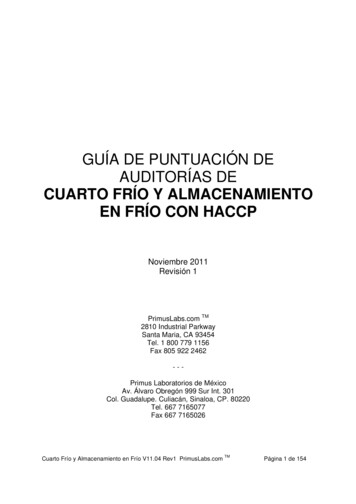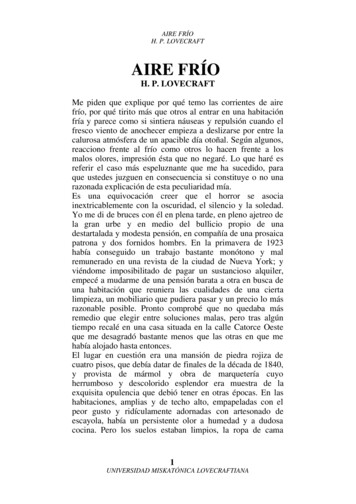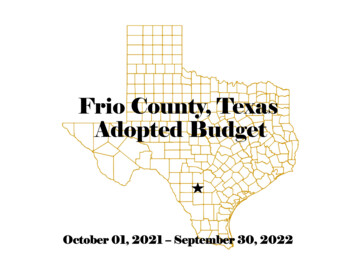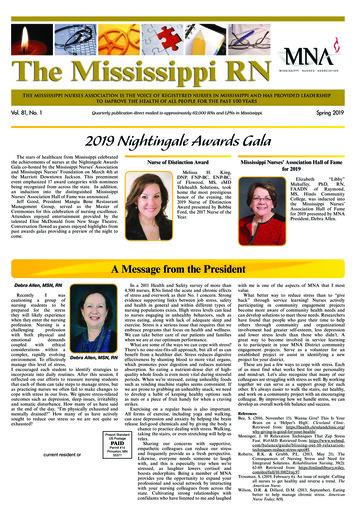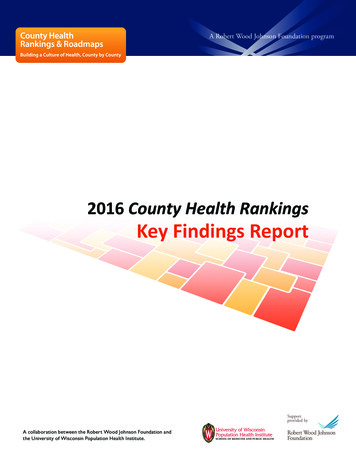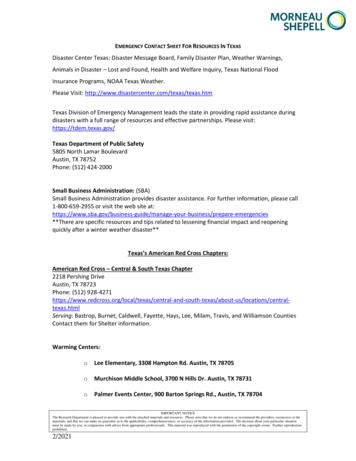
Transcription
UNITED STATES DEPARTMENT OF THE INTERIORHarold L. Ickes, SecretaryGEOLOGICAL SURVEYW. C. Mendenhall, DirectorWater-Supply Paper 676GEOLOGY AND GROUND-WATER RESOURCESOFATASGOSA AND FRIO COUNTIESTEXASBYJOHN TJUBfSK LE.Prepsired in cooper tiofy wiflh theTEXAS STATE BOARD OwitE ENGINEERSandTEXAS ENGINEERING EXPER IE%T sdTION OF THEAGRICULTURAL AND MECgtA JCAlOCOLLEGEOF TEXAS"UNITED STATESGOVERNMENT PRINTING OFFICEWASHINGTON : 1935iPor sale by the Superintendent of Documents, Washington, D. C.------Price 35 cents
CONTENTSFagtAbstract.IntroductionPurpose of investigationAcknowledgments - -l - - - - Location of area - - Topography and drainage - - -- - - - Vegetation.TransportationAgricultureHistory MapsClimateGeneral geologyRelation of the geology to the ground-water conditions.Source and disposal of the ground water. - - - -General artesian conditions - - - - --- ---Artesian conditions in Atascosa and Frio Counties.Geologic formations and their water-bearing properties - - - - Indio formationCarrizo sandMount Selman formation.Bigford member. - - - -- --- - --Post-Bigford beds .Cook Mountain formation - - - -- - - - - - Yegua formation.Jackson formation.Catahoula tuffGoliad sand -- - -- -- -- -- - Leona formationAlluviumSandstone dikesIrrigation from wellsIrrigation from wells in Carrizo sand-- -- - ------- General conditions.Frio Valley area - - - - ------ Poteet-Pleasanton areaOther areasIrrigation from wells in Mount Selman formationPearsall area - - - - --Eastern Atascosa County area fOther areasIrrigation from wells in Cook Mountain formationM unicipal water supplies from wells in Carrizo 474747484848484949505050505151
IVCONTENTSPageWater available from wells for domestic use and stockExtreme northern Atascosa County.Anchorage and Rossville area-- - -- - --- - Campbellton area- - - - - -- ----Charlotte areaChristine area.Crown area- -- - --- - - - - -- - - - ----Dobrowolski areaHindes areaJourdanton area -- - - - - - - - - - -Leming area - - - - - --- - -Pleasanton, North Pleasanton, and Coughran areaPoteet areaNorthern Frio CountyDerby areaDilley area --- ---- -- -Pearsall areaWell drilling and pumping methods- -- * - - -- -Pearsall area- - - -- - - - -- -Dilley areaPoteet areaDeep wells.Quality of the waterConservation of the water supply.Records of wells - 65657626389ILLUSTRATIONSPagePLATE 1. Geologic map of Atascosa and Frio Counties, Tex In pocket2. Map of Atascosa and Frio Counties, Tex., showing the depths tothe Carrizo sand and the heights above sea level to which waterfrom the Carrizo sand would rise in 1930 In pocket3. A, Upper part of Indio formation near Benton, Atascosa County,showing thin bedding; B, Alternating sands and shales ofIndio formation in banks of Atascosa River near Benton,Atascosa County264. A, Cross-bedded coarse-grained Carrizo sand 3 miles north ofFrio Town, Frio County; B, Contact of cross-bedded Carrizosand and thin-bedded upper part of Indio formation265. A, Pit of Osborne Gravel Co., 7 miles north of Poteet, AtascosaCounty; B, Upper beds of Mount Selman formation 1% milessoutheast of Pearsall, Frio County266. A, Alternating beds of sandstone and shaly sandstone in lowerpart of Mount Selman formation \% miles northeast of Anchorage, Atascosa County; B, Alternating sands and shales inlower part of Cook Mountain formation 5 miles southwest ofJourdanton, Atascosa County27
CONTENTSVPagePLATE 7. A, Clays with calcareous concretions in middle portion of CookMountain formation; B, Thick beds of hard Jackson sandstone in a quarry at Rockville south of Campbellton, AtascosaCounty8. A, Rotary type of water well-drilling machine; B, Percussiontype of water well-drilling machine-FIGURE 1. Map of Texas showing location of area covered by this report-2. Ideal section illustrating the chief requisite conditions forartesian wells - - - - - - - - -3. Section illustrating the thinning out of a permeable waterbearing bed4. Section illustrating the transition from a permeable waterbearing bed into a close-textured impermeable bed,42433151515
GEOLOGY AND GKOUND-WATEB EESOUBCES OFATASCOSA AND FEIO COUNTIES, TEXASBy JOHN T. LONSDALEABSTRACTAtascosa and Frio Counties are in southwestern Texas and form a part of theWinter Garden district. The purpose of the investigation here recorded was todetermine the source, quantity, and quality of the ground water used for irrigation and other purposes in the area.The rock formations exposed are of Tertiary and Quaternary age and dip towardthe east or southeast at a greater angle than the slope of the land surface, resulting in northeastward-trending belts of the outcropping formations. This general structure is modified by a large syncline in the western part of the area andby smaller anticlines and faults in other parts. These, however, do not affectgreatly the movement of ground water. In order from oldest to youngest theexposed formations are the Indio formation (800 feet thick), of Wilcox age; theCarrizo sand (425 feet), the basal or Bigford member of the Mount Selman formation (0-500 feet), the post-Bigford beds of the Mount Selman formation (700 feet),the Cook Mountain formation (600 feet), and the Yegua formation (500 feet),all of Claiborne age; the Jackson formation (500 feet); the Catahoula tuff (600feet), of Miocene age; the Goliad sand (20 feet), of Pliocene (?) age; and theLeona formation (75 feet), of Pleistocene age.The chief water-bearing formations in the area are the Carrizo sand, the MountSelman formation, and the Cook Mountain formation. The Carrizo sand cropsout in the northern part of the area and furnishes shallow wells in the outcroparea and deeper flowing and nonflowing wells south and southeast of the outcrop.Water from this formation is of good quality and is used for irrigation near Pearsail, in Frio County, and Poteet, in Atascosa County. Maps accompanying thereport show 'the outcrop of the sandstone, depths to the sandstone south andsoutheast of the outcrop, heights to which the water will rise, and the area inwhich flowing wells can be obtained.The Mount Selman and Cook Mountain formations consist of discontinuousbeds of sandstone, clay, shale, and lignite. The formations are importantsources of water for domestic use and to some extent for irrigation. The watersare of variable quality, some being highly mineralized, and vary also in quantity.Water from the Mount Selman formation is used for irrigation near Pearsall andin eastern Atascosa County, and flowing wells are obtained in this formation eastof Pearsall and near Pleasanton. The Cook Mountain formation yields waterfor irrigation near Dilley and supplies flowing wells in southeastern Frio Countyand southwestern Atascosa County near Hindes. The other formations of thearea yield smaller amounts of water for domestic use and stock. These watersalso are of variable quality, many being highly mineralized.The investigation showed that a considerable amount of water from flowingwells is being wasted. If this water were conserved considerable additionalirrigation could be carried on. Measurements of the water level in wells fromthe Carrizo sand (still being continued) lead to the tentative conclusion that the'safe yield from this formation has not been exceeded.1
tGROUND WATEE OF ATASCOSA AND FKIO COUNTIES, TEX.INTRODUCTIONPURPOSE OF INVESTIGATIONThis report covers the results of an investigation in Atascosa andFrio Counties, Tex., which was begun in 1929 under the direction ofthe Engineering Experiment Station of the Agricultural and Mechanical College of Texas at the joint request of the officials of the MissouriPacific Kailroad and of residents in the area. Early in 1930 anarrangement was made to incorporate the investigation into the general program of ground-water investigations which is being carriedout by the State Board of Water Engineers through cooperation withthe United States Geological Survey and which covers several adjacentor nearby counties, including Dimmit, Zavala, Medina, UvalderDuval, and Webb. This report, therefore, represents the results ofa cooperative project between the Engineering Experiment Station,the Texas Board of Water Engineers, and the United States GeologicalSurvey. The investigation was undertaken for the purpose of determining the resources of ground water in the area with special referenceto the supply available for irrigation. The field work occupied June,July, and August in both 1929 and 1930, a part of December in 1931,and a part of June in 1932. During the season of 1929 an office wasmaintained at Pearsall, and in 1930 offices were maintained at bothPearsall and Jourdanton. During the season of 1930 the writer wa&ably assisted by M. T. Halbouty.ACKNOWLEDGMENTSThe writer is indebted to many persons who contributed information and assistance in the field and assisted in the preparation of thisreport. Mr. W. B. Cook, of the Missouri Pacific Railroad, and hi&associates cooperated by supplying engineering and agricultural data.Mr. N. H. Hunt and Mr. L. F. Merl, secretaries respectively of thePearsall and Dilley Chambers of Commerce, contributed data concerning wells and extended many courtesies. Well logs were suppliedby Mr. W. D. Morrison, of Dilley; Mr. C. S. Young, of Jourdanton;Mr. F. M. Getzendaner and Mr. L. F. McCollum, of the Humble Oil& Refining Co.; and Mr. J. M. Dawson, of the Gulf Production Co.Mr. Getzendaner also gave freely of his store of geologic informationrelating to the area. Messrs. A. R. Denison and L. W. Clark, of theAmerada Petroleum Corporation,, supplied information concerningCook Mountain contacts in Frio County and oil wells drilled bythe company. Miss Julia Gardner, of the United States GeologicalSurvey, identified fossils collected by the writer and helped him tomap geologic boundaries in parts of the area. Mr. W. N. White, ofthe Geological Survey, who is in charge of the ground-water investigation in Texas, spent several days in the field with the writer and
LOCATION OF AEEAhas reviewed and to some extent revised this report. Geologic andhydrologic data were supplied by Messrs. A. N. Sayre, T. W. Robinson, and S. F. Turner, also of the Geological Survey, who were makingsimilar investigations in adjoining areas in Dimmit, Uvalde, andMedina Counties. Use was also made of unpublished hydrologic97300 MilesFIGURE 1. Map of Texas, showing location of Atascosa and Frio Counties.data in the files of the United States Geological Survey collected byMessrs. Alexander Deussen and S. S. Nye. The investigation wasmade under the general direction of Mr. O. E. Meinzer, geologist incharge of the division of ground water in the Geological Survey.LOCATION OF AREAAtascosa and Frio Counties are in southwestern Texas (see fig. 1)and comprise a part of the area that is commonly called the WinterGarden district, the boundaries of which are rather loosely defined.Atascosa County has an area of 1,350 square miles and Frio County
4GROUND WATER OF ATASCOSA AND FRIO COUNTIES, TEX.1,124 square miles. The principal towns are Poteet, Pleasanton,North Pleasanton, Jourdanton, Lytle, Christine, and Campbellton,in Atascosa County; and Moore, Pearsall, Derby, Melon, Dilley,and Bigfoot, in Frio County.TOPOGRAPHY AND DRAINAGEAtascosa and Frio Counties are within the Western Gulf section ofthe Coastal Plain, which in this part of Texas extends from theEdwards Plateau, on the north and northwest, to the Gulf of Mexico,on the south and southeast. The general pattern of the surface isthat of a uniform southeastward slope, somewhat dissected bysoutheastward-flowing streams. Thus Lytle, in the northwesternpart of Atascosa County, has an altitude of about 730 feet above sealevel, and Campbellton, in the southern part of the same county, hasan altitude of only about 250 feet. In some parts the surface formsa true plain with very little relief, but in general the interstreamareas are belts of relatively high land that have a southeasterlytrend. In some places the more resistant beds have formed escarpments that face west or north. The greatest relief is in the northernpart of the area, especially in northwestern Frio County, where theoutcropping rocks contain beds of variable hardness and the streamshave dissected the once uniform upland into prominent hills andvalleys.The principal streams of the area are the Frio, Atascosa, andLeona Rivers and San Miguel Creek. Minor streams of. someimportance are Hondo, Seco, Lagunillas, Siestadero, and TurkeyCreeks. All these streams are intermittent. Floods occur duringand immediately after heavy rains, but these floods subside in a fewhours or at the most in a few days, and during the greater part of thetime the streams either are dry or contain disconnected pools whichdwindle during protracted periods of drought until little or no waterremains. The channels of the Frio River in the region below Derbyand of the Atascosa River below Poteet contain water nearly all theyear. This is partly due to the inflow of waste water from artesianwells, that are allowed to flow continually.The amount of standing water in the stream channels during drytimes is related to the character of the underlying rocks. In sandstone areas the stream channels are usually completely dry at suchtimes, but in shale areas they frequently contain pools of water forlong periods. This difference gives a clue as to the source of some ofthe ground water in the sandstone formations of the area.The larger streams are bordered by belts of alluvium, but theseare narrow and poorly defined except along the Frio and AtascosaRivers and San Miguel Creek in the southern part of the area. The
TRANSPORTATION5alluvial deposits do not enter into the ground-water problems of thedistrict.VEGETATIONThe native vegetation reflects to a degree the semiarid subtropicalcharacter of the climate. Nearly everywhere the uncultivated areasare covered with a growth of varying density of scrub trees or chaparral. The trees consist dominantly of mesquite in the western partof the area and of mesquite and scrub oak in the eastern part. Thechaparral consists chiefly of black brush, catclaw, juahillo (wah-ee'yo),scrub mesquite, and prickly pear and other types of cactus. Nearthe streams are found trees of considerable size, such as the pecan,cypress, and live oak. Oaks of fairly large size also occur on thedivides between the streams in the eastern part of the area. A varietyof grasses flourish in open spaces among the trees and chaparral.TRANSPORTATIONThe area is crossed by branch lines of the Missouri Pacific Railroad.The International-Great Northern Railroad passes in a north-south,direction through the northwestern part of Atascosa County and thecentral part of Frio County. Moore, Pearsall, Melon, Derby, andDilley, in Frio County, are on this line. One branch of the SanAntonio, Uvalde & Gulf division of the Missouri Pacific Railroadpasses through north-central Atascosa County and another throughthe southern part of the county, the towns of Leming, Pleasanton,Jourdanton, Dobrowolski, Charlotte, and Hindes being on the firstnamed branch and Coughran, McCoy, and Campbellton on the other.A third line, the San Antonio Southern Railway, passes throughPoteet and Jourdanton and terminates at Christine.Both Atascosa and Frio Counties are provided with good trunkautomobile roads. State highway 2, between San Antonio and Laredo,passes through Frio County, following the line of the InternationalGreat Northern Railroad. State highway 85, from Dilley to EaglePass, crosses the southwestern part of the county. Highway 9crosses Atascosa County from north to south through Leming,Pleasanton, and Campbellton, and a short branch of it (highway 97)extends from Pleasanton to Jourdanton. In the northern part of thecounty the Palo Alto road from San Antonio extends to Poteet.All the highways converge at San Antonio, which is the supply andmarket point for tne area. Secondary automobile roads, which aregenerally graded and open for travel except in very bad weather,connect all parts of the area. It should be noted that dirt roads passing over certain of the clay formations, such as the Yegua, are impassable after heavy rains.
6GROUND WATER OF ATASCOSA AND FRIO COUNTIES, TEX.AGRICULTUREAtascosa and Frio Counties are to some extent in a stage of transition from stock raising to farming. Until within a comparatively fewyears very little farming was carried on, and practically the entirearea in both counties was devoted to cattle raising. Some of the mostfamous early ranches in Texas were located in this area.In recent years farming has been on the increase, much of the development having started with the building of the railroads. In most ofthe area dry farming is practiced. Cotton is raised extensively, andin Atascosa County it is the largest crop, but in Frio County therainfall in many years is insufficient to mature the cotton. Corn,various sorghums, and other dry-land crops are raised.Winter truck farming, with irrigation from wells, has becomeimportant in the area. Poteet furnishes large amounts of earlystrawberries and vegetables. Areas around Pearsall and Dilleyfurnish onions, spinach, tomatoes, and other vegetables. Largetracts still remain and probably will continue to remain as ranch land,but in general farming is being extended. According to the agricultural census of the United States, 37.9 percent of Atascosa Countyand 54.8 percent of Frio County were in farms in 1925. Below is atable compiled from the 1925 census showing the kinds of cropsraised and the acreage devoted to each crop. The table does notinclude strawberries, because information was not available as to theacreage of that crop.Farm acreage of crops raised in Atascosa and Frio Counties, Tex., in 1925AtascosaFrioCounty CountyWheat - . --- ---.-- .Oats. .- .-.869, 12081, 45522,915501071,6131,8073,15081719, 360W oqq99 J.Q4542724,91950199Atascosa FrioCounty STORYThe history of Atascosa and Frio Counties is an interesting story ofthe winning of frontier lands from Indians, the .development of ranching, the building of railroads, and finally a gradual change into acombination of ranching and farming. Only a brief summary of thishistory can be given here.Venturesome stockmen established themselves in the area in theearly fifties. At that time and for 25 years afterward the region wassubject to Indian raids, the Frio County area being the more vulnerable because of its greater distance from San Antonio.
MAPS/Atascosa County was delimited and organized in 1871. The countyseat was first at Novatascosa, but later it was moved to Pleasantonand still later to Jourdanton. Until 1908 the only railroad in thecounty passed through the extreme northwestern part. In 1908 and1909 two railroads, the San Antonio, Uvalde & Gulf and the SanAntonio Southern, were built into the county, and Jourdanton, Poteet, and Christine were established as stations on them.The first flowing well at Poteet, in Atascosa County, was drilled in1904. before the advent of the railroad, and this demonstration of theavailability of artesian water had much to do with the initiation ofrailroad building in the area. By 1910 there were 10 artesian wells,and thereafter several were drilled each year until the period of theWorld War, when drilling was stopped on account of the high costof sinking the wells and providing them with pumping equipment.More recently well drilling has been resumed, and there are now morethan 50 artesian wells in the Poteet area. The development of truckfarming has paralleled the sinking of the artesian wells.Frio County was also organized in 1871, with the county seat atFrio Town. In 1881 the county seat was moved to Pearsall, then anew town on the International-Great Northern Railroad, which hadrecently been built through the county. The original courthouseat Frio Town is still intact and is one of the historic landmarks of theregion.The first flowing well in Frio County was drilled near Pearsall in1905. Since then, deep wells have been drilled from time to time inthe Frio Valley area, west and southwest of Pearsall. Most of thesewells flow and furnish water for irrigation of considerable extent.Irrigation with water pumped from shallow wells was started in thePearsall area in 1905, and the development reached its height about1923. Pump-well irrigation was begun in the vicinity of Dilley about1925 and has since gradually developed.MAPSTwo maps accompany this report. Plate 1 shows the areal geology,the original and present areas of artesian flow, and the location ofrecord wells and of lands irrigated with water from wells. Plate 2shows the depths to the top of the Carrizo sand and the height abovesea level to which water from the Carrizo sand would rise in 1930.The map of Frio County used as a base for showing the geologic andhydrologic data was .traced from a soil map of the county prepared byM. W. Beck, of the United States Department of Agriculture, andmade available through the courtesy of Mr. A. B. Conner, director ofthe Texas Agricultural Experiment Station. The base map of Atascosa County was prepared by M. T. Halbouty, by compilation of
8GROUND WATER OF ATASCOSA AND FRIO COUNTIES, TEX.data from existing county and land maps and by a plane-table traversewhich covered about one-third of the county.CLIMATETexas is remarkable for its great variety of climate. The extremeeastern part of the State has an average annual rainfall of more than45 inches. The precipitation decreases gradually from east to west,the annual average being less than 30 inches at San Antonio and lessthan 20 inches at Eagle Pass. Atascosa County on the average receives 25 to 30 inches annually as compared with 20 to 25 inches inFrio County.There is a considerable range in temperature in the two counties.Summer temperatures are frequently higher than 100 and during thewinter there is generally at least one killing frost. During the periodof record the growing season has varied from 220 to 298 days. Observations made intermittently since 1908 record a minimum temperature of 13 .In most years there is some rain every month. The heaviest precipitation usually occurs in April, May, and the early part of Juneand in September and October. February is also a wet month, especially in Frio County. August is the driest month. There is atendency for the precipitation to be concentrated in heavy rains, whichfrequently cause floods. In many years there is a decided shortageof rainfall during the summer, especially in July and August. Cropstherefore must be specially adapted to dry farming or must be irrigated.Tables showing available records of rainfall and dates of the firstkilling frost in the fall and the last killing frost in the spring in thetwo counties, and of rainfall at Kunge, in Karnes County, are givenbelow, from reports of the United States Weather Bureau.
-.1911.1912. .1913.1914.1915.- .1916.1917.1918. . .1919- - .1920-1921.- .1922., . . .1923-1924.19251926. .1927.19281929.1910-. 9Tr.782.221.001.00Aug.Precipitation 80.463.280.702.501.252.003.10Nov.Climatic data for Dilley, Frio County, Tex., 7Firstkillingfrost infall21 Dec. 94 Dec. 1920 Dec. 1415 Dec. 1929 Nov. 2326 Dec. 30Dec. 826 Dec. 2313 Nov. 6Lastkillingfrost inspring30 Feb.24 Mar.23 Mar.Mar.22 Jan.25 Jan.2518 Feb.21 Feb.MiniAnnual MaxiTTH1TT1mumTemperature ( )
.1904 . . .1905.1909 . .--.-----.--.19101911-.--.----.-- . .-. . .1912. .1913. .1914. .1915--.1916-.1917.1918. . . .-.-.-. - . .1919-. .19201921. . . .1922.1923.1924. . . . . ug.Precipitation 71.31Sept.Climatic data for Pearsail, Frio County, Tex., 128.47Feb. 6Mar. 3Mar. 17Mar. 14Feb. 23Feb. 18Feb. 21Feb. 20Lastkillingfrost inAnnual spring4182113Nov. 15Nov. 28Nov. 15Dec. 6Nov. 29Nov. 28Dec.Nov.Nov.Nov.Firstkillingfrost infall
19221923-1924.19251915-1916191719181919--.1920- .1907. .1908-.-.1909.1910.-.1911.- tation 46Tr.5.291.25.05Dec.Climatic data for Rossville, Atascosa County, Tea?., 1907 525.8227.6226.149.5029.6861.0626.4210522.3Mar. 20Mar. 14Feb. 28104105106242221108Nov.Dec.Nov.Nov.26142523Nov. 1517 Dec. 819 Oct. 2923 Nov. 1327 Nov. 217 Oct. 2722 Dec. 1022 Nov. 159 Nov. 145 Oct. 303 Nov. 2826 Dec. 105 Nov. r.Feb.Maxi-Annual mumFirstLast kill- killinging frost frost inMini- in springin fallmumTemperature ( ) 23H2
12GROUND WATER OF ATASCOSA AND FBIO COUNTIES, TEX.Annual precipitation, in inches, at Runge, Karnes County, Tex., 1895-19291896 .1898 .1899 .19001901 .1902 .1903. .1904 .1905 . .27.30248427. 3837.22242639. 5445.0332.3536. 111907. . .1908.1909- . .1910--- . 1911- .1912 .1913 .1914 .1915 .25. 4231. 7618.9428.3327.9022.6430. 7340.3920.241916 - .1Q17.1918 .1919 .1920 .1921 .1922 .1923 .1924-. .18.5513. 6030. 7545.8425. 6230.0829.3845. 1020.651925 . e- 28. 99GENERAL GEOLOGYThe rock formations exposed in Atascosa and Frio Counties are ofTertiary and Quaternary age, but Upper Cretaceous and LowerCretaceous formations have been encountered in a considerablenumber of deep wells drilled for oil in the central and northern partsof the area, and they doubtless everywhere underlie the exposedformations. There are many problems of stratigraphy and correlation in the area, but most of them are not within the scope of thisreport. Plate 1 shows the outcrops of the formations except depositsof Pliocene (?) and Quaternary age. The geologic table on page 18shows the relations and characteristics of the several formationspresent.The information concerning the unexposed formations is based ontheir character as observed at their outcrops north of Frio and Atascosa Counties and on data obtained from the deep
for irrigation near Dilley and supplies flowing wells in southeastern Frio County and southwestern Atascosa County near Hindes. The other formations of the area yield smaller amounts of water for domestic use and stock. These waters also are of variable quality, many being highly mineralized.
